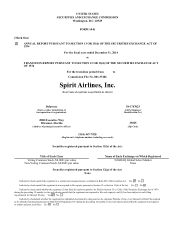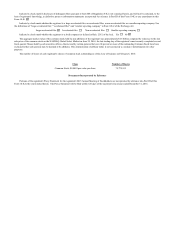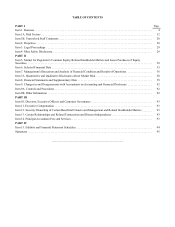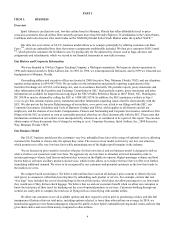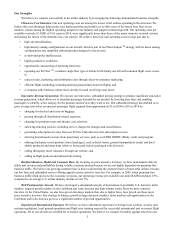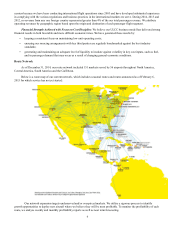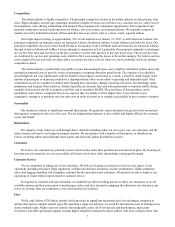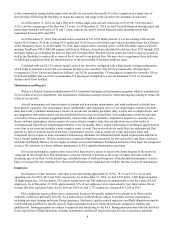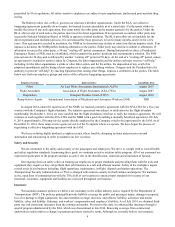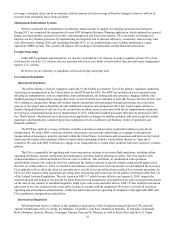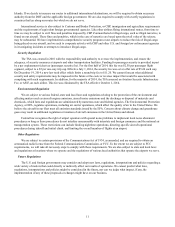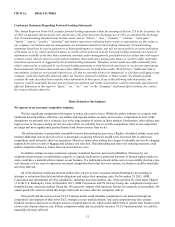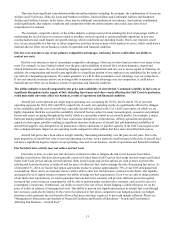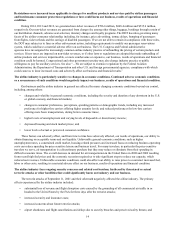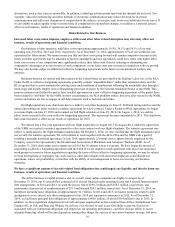Spirit Airlines 2014 Annual Report Download - page 9
Download and view the complete annual report
Please find page 9 of the 2014 Spirit Airlines annual report below. You can navigate through the pages in the report by either clicking on the pages listed below, or by using the keyword search tool below to find specific information within the annual report.
9
prescribed by FAA regulations. All safety-sensitive employees are subject to pre-employment, random and post-accident drug
testing.
The Railway Labor Act, or RLA, governs our relations with labor organizations. Under the RLA, our collective
bargaining agreements generally do not expire, but instead become amendable as of a stated date. If either party wishes to
modify the terms of any such agreement, they must notify the other party in the manner agreed to by the parties. Under the
RLA, after receipt of such notice, the parties must meet for direct negotiations. If no agreement is reached, either party may
request the National Mediation Board, or NMB, to appoint a federal mediator. The RLA prescribes no set timetable for the
direct negotiation and mediation process. It is not unusual for those processes to last for many months, and even for a few
years. If no agreement is reached in mediation, the NMB in its discretion may declare at some time that an impasse exists. If an
impasse is declared, the NMB proffers binding arbitration to the parties. Either party may decline to submit to arbitration. If
arbitration is rejected by either party, a 30-day “cooling off” period commences. During that period (or after), a Presidential
Emergency Board, or PEB, may be established, which examines the parties’ positions and recommends a solution. The PEB
process lasts for 30 days and is followed by another “cooling off” period of 30 days. At the end of a “cooling off” period, unless
an agreement is reached or action is taken by Congress, the labor organization and the airline each may resort to “self-help,”
including, for the labor organization, a strike or other labor action, and for the airline, the imposition of any or all of its
proposed amendments and the hiring of new employees to replace any striking workers. Congress and the President have the
authority to prevent “self-help” by enacting legislation that, among other things, imposes a settlement on the parties. The table
below sets forth our employee groups and status of the collective bargaining agreements.
Employee Groups Representative Amendable Date
Pilots Air Line Pilots Association, International (ALPA) August 2015
Flight Attendants Association of Flight Attendants (AFA-CWA) August 2007
Dispatchers Transport Workers Union (TWU) August 2018
Ramp Service Agents International Association of Machinists and Aerospace Workers (IAM) TBD
In August 2014, under the supervision of the NMB, we reached a tentative agreement with the AFA-CWA for a five-year
contract with the Company's flight attendants. The tentative agreement was subject to ratification by the flight attendant
membership. On October 1, 2014, we were notified that the flight attendants voted not to ratify the tentative agreement. We will
continue to work together with the AFA-CWA and the NMB with a goal of reaching a mutually beneficial agreement. On July
8, 2014, approximately 250 ramp service agents directly employed by the Company voted to be represented by the IAM. As of
December 31, 2014, these ramp service agents served 4 of the 56 airports where we operate. We have begun the process of
negotiating a collective bargaining agreement with the IAM.
We focus on hiring highly productive employees and, where feasible, designing systems and processes around
automation and outsourcing in order to maintain our low cost base.
Safety and Security
We are committed to the safety and security of our passengers and employees. We strive to comply with or exceed health
and safety regulation standards. In pursuing these goals, we maintain an active aviation safety program. All of our personnel are
expected to participate in the program and take an active role in the identification, reduction and elimination of hazards.
Our ongoing focus on safety relies on training our employees to proper standards and providing them with the tools and
equipment they require so they can perform their job functions in a safe and efficient manner. Safety in the workplace targets
several areas of our business including: flight operations, maintenance, in-flight, dispatch and station operations. The
Transportation Security Administration, or TSA, is charged with aviation security for both airlines and airports. We maintain
active, open lines of communication with the TSA at all of our locations to ensure proper standards for security of our
personnel, customers, equipment and facilities are exercised throughout our business.
Insurance
We maintain insurance policies we believe are customary in the airline industry and as required by the Department of
Transportation (DOT). The policies principally provide liability coverage for public and passenger injury; damage to property;
loss of or damage to flight equipment; fire and extended coverage; directors’ and officers’ liability; advertiser and media
liability; cyber risk liability; fiduciary; and workers’ compensation and employer’s liability. As of July 2014, we obtained third-
party war risk (terrorism) insurance from the commercial market. Previous to this date, we obtained this insurance through a
special program administered by the FAA, which was discontinued in late 2014. Renewing coverage from commercial
underwriters could result in a change in premium and more restrictive terms. Although we currently believe our insurance

